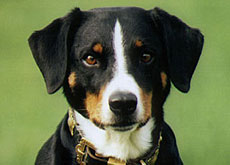
Breeding problems may silence rare dog’s bark

A society for the promotion of the rare dog breed, the Appenzell Sennenhund, is marking its centenary, but has had little to bark about. The breed is still endangered.
The indigenous Swiss animal, also known as the Appenzell Cattle or Mountain Dog, has been used in the herding of cattle in the eastern canton for 500 years.
According to the Appenzell Sennenhund Club, the dog was first described in a book, “Animal Life in the Alps” in 1853: “[It’s] a loud barking, short-haired, medium size, multicoloured cattle dog… used partly to guard the homestead, partly to herd cattle”.
The club was set up to preserve the Sennenhund in 1906, introducing a registry for puppies to promote purebreds, which are distinct from other Swiss cattle dogs.
But its gene pool remained so small that the club sought support in 1997 from the organisation, Pro Specie Rara, a foundation aimed at preserving indigenous and endangered plants and animals.
In a first phase the foundation purchased males from rare Sennenhund lines and placed them on Appenzell farms.
This was deemed an important gesture, since many farmers use mixed breeds or other kinds of dogs since the rarity of the indigenous animal makes it expensive to buy.
Unfortunately, only two of the first ten dogs taking part in the project proved suitable for breeding.
Pro Specie Rara shifted its focus to dog training and owner education, and since many people are afraid of the Sennenhund, launched a public relations campaign to convince a wider public that its bark is worse than its bite.
It published a brochure informing hikers how to behave when approached by the dog.
First litter
The foundation was eventually able to place a dozen purebred dogs on farms before it wrapped up its project earlier this year.
A first litter was born to one of the Sennenhund and a second is expected to give birth soon.
But farmers remain sceptical. Patience and skill are required to train the intelligent, hardworking animal, and its value has diminished with the increasing usage of electric fences to keep herds together.
The Sennenhund’s ability to save lives may in the end save it from extinction. It has become highly valued in search and rescue missions, and as a guide dog.
swissinfo with agencies
The Appenzell Sennenhund is one of four indigenous breeds of Swiss Cattle Dogs – the others being the Entlebuch, Bernese and Greater Swiss.
The Appenzell is a very spirited animal with great endurance and flexibility. It is able to read the facial and body expressions of its master.
Its inborn guarding and herd-driving instincts and limited hunting sense make it a reliable farm and family dog.
Breeding programmes for the Appenzell Sennenhund were first introduced in 1898.
The Appenzell Sennenhund Club was founded in 1906 to preserve and promote purebreds. It celebrates its centenary on August 26.
The standard breed recognised today was agreed upon in 1914.

In compliance with the JTI standards
More: SWI swissinfo.ch certified by the Journalism Trust Initiative





























You can find an overview of ongoing debates with our journalists here . Please join us!
If you want to start a conversation about a topic raised in this article or want to report factual errors, email us at english@swissinfo.ch.